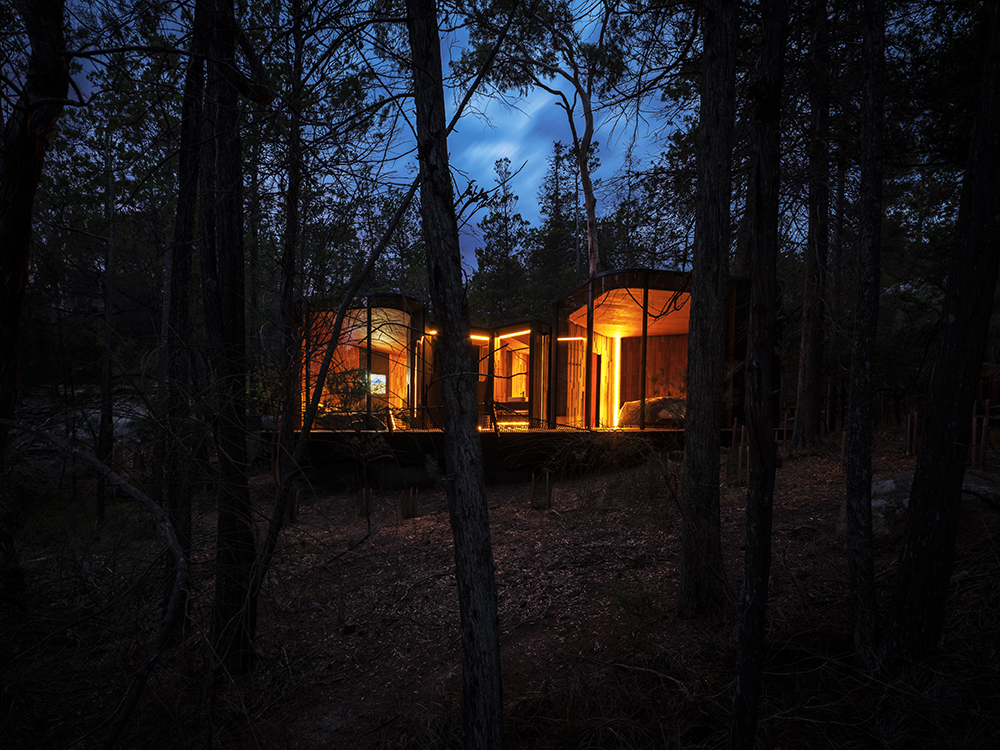
Inspired by Nature - The Coastal Pavilions at Freycinet Lodge by Liminal Studio
Ancient masses of pink granite, worn smooth by wind and sea, on the shores of Honeymoon Bay in Tasmania’s Freycinet National Park provided a powerful source of inspiration for Liminal Studio’s design of the Coastal Pavilions at Freycinet Lodge.
The pavilions are designed to rest lightly within the coastal landscape. Tourism entrepreneur Brett Torrosi was engaged by Freycinet Lodge owners RACT to project manage the development of the Coastal Pavilions in collaboration with Liminal Studio. The development team brought in specialist ecologist Mark Wapstra to survey the site and identify the species of flora and fauna inhabiting the area to ensure the project’s impact on this sensitive ecology was minimised. Management strategies were devised to ensure the ongoing sustainability of the area, and as traditional building works would have been damaging to the environment, the pavilions were constructed off-site by builders Cordwell Lane.
Every element of the architecture and interiors makes reference to the natural environment in which the pavilions have been placed. Liminal Studio drew on the organic formations of the coastal granite, for which Freycinet National Park is renowned, in creating the pavilions’ distinctive curved forms. Curved glazing reduces barriers between guests and the natural environment outside, while the positioning of the living space and bedroom wing create an embrace reminiscent of the coastline of nearby Honeymoon Bay.
Decking wraps the pavilions, with the angle of the two wings creating privacy for an outdoor bath. Recognising that traditional balustrading around the deck would interrupt the flow between built and natural environments, Liminal Studios devised an innovative netting solution. The netting not only removes the need for a balustrade but creates an experiential feature that allows guests to lie suspended within the landscape in the hammock-like nets.
Charred ironbark timber external cladding references the role of fire in the ecosystem and creates dark structures that recede into the surrounding natural vegetation. Moving inside, the interiors are immersed in the warmth of Tasmanian timbers, with stained offcuts of Tasmanian oak, Tasmanian blackwood and the only plywood manufactured in Tasmania. The Coastal Pavilions mark the first time the ply has been used as a featured finish, as it is normally a structural ply and, therefore, hidden. In this way, the timber-lined interiors embody both a delicacy and a utilitarian strength, creating a unique interplay that energises the spaces.
Project manager Brett Torrosi and Liminal Studios worked together to commission a series of artwork to complement the spaces and reflect the natural environment that was so influential to the design. The lightbox works of local artists Helen Weeding and collaborators Bridgette de Villiers and Bill Cromer, of Landslide, were inspired by the wild and contrasting landscape of Freycinet National Park. Each work references the space between earth and sky, water and stone in an artistic response to the same inspiration that informed the architectural design.
Through an innovative and sensitive response to a site of significant ecological value, Liminal Studios intersect design and nature. In doing so, the Coastal Pavilions create a unique opportunity for guests to experience being fully immersed in both.

![Book Flatlay Cover Front Transparent Trio[1]](https://d31dpzy4bseog7.cloudfront.net/media/2024/06/07080212/Book_Flatlay_Cover_Front_Transparent_Trio1.png)










































